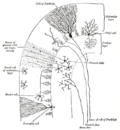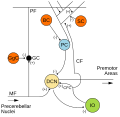Purkinje cell
Purkinje cell
The Purkinje cell or Purkinje neuron is a type of neuron found in the cerebellar cortex of the brain. Named after the Czech anatomist Jan Evangelista Purkyně who discovered them, these cells are some of the largest neurons in the human brain.
Structure[edit]
Purkinje cells are characterized by a highly elaborate dendritic arbor, filled with a vast number of dendritic spines. These cells are found within the Purkinje layer in the cerebellar cortex. They are aligned like dominos stacked one in front of the other.
Function[edit]
Purkinje cells send inhibitory projections to the deep cerebellar nuclei, and constitute the sole output of all motor coordination in the cerebellar cortex.
Clinical significance[edit]
Several disorders are known to affect Purkinje cells, including spinocerebellar ataxias, Unverricht-Lundborg disease, and Autism spectrum disorder. Damage to the Purkinje cells can result in loss of coordination and balance, known as ataxia.
History[edit]
Purkinje cells were discovered in 1837 by the Czech anatomist Jan Evangelista Purkyně, who was the first to describe these large neurons.
See also[edit]
References[edit]
<references />
External links[edit]
- Purkinje cell at Wikipedia
|
|
|
-
Purkinje cell
-
Neurons (Purkinje cells)
-
Gray's Anatomy illustration of Purkinje cells
-
Cerebellum silver stain
-
Cerebellum - Bielschowsky stain, very high magnification
-
All that glitters in the brain
-
PCP4 immunohistochemistry in human cerebellum
-
Diagram of the Microanatomy of Human Cerebellar Cortex
Ad. Transform your life with W8MD's Budget GLP-1 injections from $75


W8MD offers a medical weight loss program to lose weight in Philadelphia. Our physician-supervised medical weight loss provides:
- Weight loss injections in NYC (generic and brand names):
- Zepbound / Mounjaro, Wegovy / Ozempic, Saxenda
- Most insurances accepted or discounted self-pay rates. We will obtain insurance prior authorizations if needed.
- Generic GLP1 weight loss injections from $75 for the starting dose.
- Also offer prescription weight loss medications including Phentermine, Qsymia, Diethylpropion, Contrave etc.
NYC weight loss doctor appointmentsNYC weight loss doctor appointments
Start your NYC weight loss journey today at our NYC medical weight loss and Philadelphia medical weight loss clinics.
- Call 718-946-5500 to lose weight in NYC or for medical weight loss in Philadelphia 215-676-2334.
- Tags:NYC medical weight loss, Philadelphia lose weight Zepbound NYC, Budget GLP1 weight loss injections, Wegovy Philadelphia, Wegovy NYC, Philadelphia medical weight loss, Brookly weight loss and Wegovy NYC
|
WikiMD's Wellness Encyclopedia |
| Let Food Be Thy Medicine Medicine Thy Food - Hippocrates |
Medical Disclaimer: WikiMD is not a substitute for professional medical advice. The information on WikiMD is provided as an information resource only, may be incorrect, outdated or misleading, and is not to be used or relied on for any diagnostic or treatment purposes. Please consult your health care provider before making any healthcare decisions or for guidance about a specific medical condition. WikiMD expressly disclaims responsibility, and shall have no liability, for any damages, loss, injury, or liability whatsoever suffered as a result of your reliance on the information contained in this site. By visiting this site you agree to the foregoing terms and conditions, which may from time to time be changed or supplemented by WikiMD. If you do not agree to the foregoing terms and conditions, you should not enter or use this site. See full disclaimer.
Credits:Most images are courtesy of Wikimedia commons, and templates, categories Wikipedia, licensed under CC BY SA or similar.
Translate this page: - East Asian
中文,
日本,
한국어,
South Asian
हिन्दी,
தமிழ்,
తెలుగు,
Urdu,
ಕನ್ನಡ,
Southeast Asian
Indonesian,
Vietnamese,
Thai,
မြန်မာဘာသာ,
বাংলা
European
español,
Deutsch,
français,
Greek,
português do Brasil,
polski,
română,
русский,
Nederlands,
norsk,
svenska,
suomi,
Italian
Middle Eastern & African
عربى,
Turkish,
Persian,
Hebrew,
Afrikaans,
isiZulu,
Kiswahili,
Other
Bulgarian,
Hungarian,
Czech,
Swedish,
മലയാളം,
मराठी,
ਪੰਜਾਬੀ,
ગુજરાતી,
Portuguese,
Ukrainian










